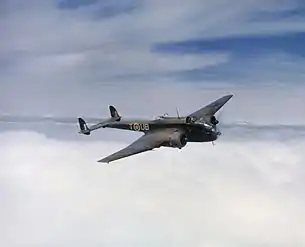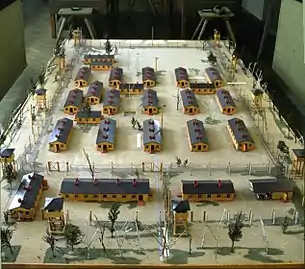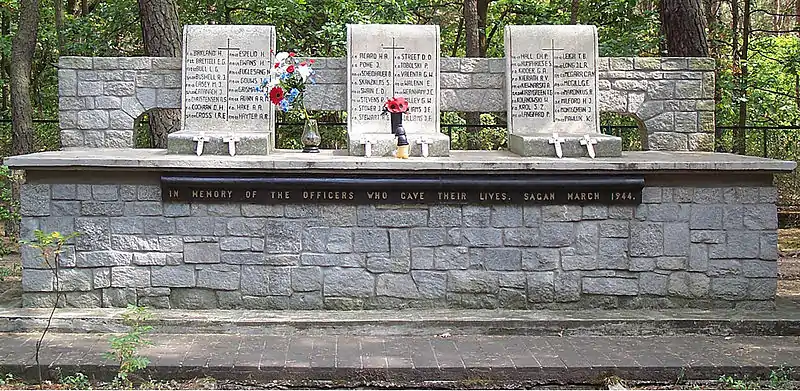James Catanach
James Catanach (28 November 1921 – 29 March 1944), known as "Jim" or Jimmy, was an Australian Handley Page Hampden bomber pilot who was taken prisoner during the Second World War. Reportedly the youngest squadron leader bomber pilot in the Royal Australian Air Force at the age of twenty he is notable for the part he took in the 'Great Escape' from Stalag Luft III in March 1944 and as one of the men re-captured and subsequently shot by the Gestapo.
James Catanach | |
|---|---|
.jpg.webp) RAAF airmen on the set of the BBC's Anzac Hour radio show, 1942. Catanach is in the centre (in uniform). | |
| Birth name | James Catanach |
| Nickname(s) | Jim |
| Born | 28 November 1921 Melbourne, Victoria, Australia |
| Died | 29 March 1944 (aged 22) near Kiel, Free State of Prussia, Nazi Germany |
| Buried | Poznan Old Garrison Cemetery, Poland |
| Allegiance | Australia |
| Service/ | |
| Years of service | 1940–44 |
| Rank | Squadron Leader |
| Service number | Aus.400364 |
| Unit | No. 455 Squadron RAAF |
| Battles/wars | World War II |
| Awards | Distinguished Flying Cross, Mentioned in despatches |
Pre-war life
Catanach was born in Melbourne, Victoria, Australia the son of Ruby and William Catanach a successful jeweller. He attended Brighton Grammar School from 1929 to 1931 and then Geelong Grammar School where he spent three years in the cadet corps. After graduating in 1938 he went to work with his older brother, Bill, in the family business.[1][2]
War service
James Catanach was a salesman until he joined the Royal Australian Air Force on 18 August 1940, to learn to fly.[3][4] Meanwhile, his brother enlisted in the Army.[5] On completion of basic initial training at Somers and Narrandera Catanach was posted to Canada where he learned to fly and received his pilot’s wings in June 1941 being commissioned pilot officer.[1] He was subsequently posted to Great Britain to fly with RAF Bomber Command. Initially flying with No. 144 Squadron RAF, he was transferred to No. 455 Squadron RAAF after completing nine missions.[5]
No. 455 Squadron RAAF formed at RAF Swinderby, in Lincolnshire and had received Handley Page Hampden bombers by the time the bulk of the Australian personnel arrived on 1 September 1941, having departed Australia by sea on 15 June. Initially assigned to No. 5 Group RAF, Bomber Command in a bomber role, its first operation took place while the squadron was still forming, when a single Hampden attacked Frankfurt at night on 29 August. In doing so, according to the Australian War Memorial, the squadron had the distinction of becoming the "first Australian squadron to bomb Germany". Following this, the squadron increased its operational tempo, undertaking several mine laying operations off the coast of occupied France, as well attacking industrial targets in Germany.[6] These missions were flown by Jim Catanach.[7]

In February 1942, the squadron took part in an unsuccessful attack on the German battleships Scharnhorst and Gneisenau, before being re-roled as a torpedo-bomber squadron and transferred to RAF Coastal Command on 26 April 1942; they subsequently deployed a detachment briefly to Vaenga (now Severomorsk) in the Soviet Union in September.[8] Catanach had completed nine operations with RAF Bomber Command before the transfer.[1] The detachment was to operate in support of convoys bound for Russia, which were at the time suffering heavy losses. However, three of the 16 Hamptons were lost prior to arrival, one of them flown by Catanach. After completing one anti-shipping sweep with the Russians the remaining aircraft were handed over to the Soviet Air Forces with the RAAF crews instructing the Soviets on their operation. Following the completion of this task the squadron returned to RAF Sumburgh. In June 1942, Catanach was promoted squadron leader, becoming reputedly the youngest in the Royal Australian Air Force to hold that rank.[1][4][9]
Prisoner of war
Catanach and his crew took off in Handley Page Hampden serial number "AT109" from RAF Sumburgh at 20:40 hours on the night of 4/5 September 1942 for Vaenja, Northern Russia, via Afrikanda. Nearing the end of the long flight his aircraft was holed in the petrol tanks by ground fire or heavy machine gun fire from a German trawler and Catanach force landed under fire on the shoreline near Kirkenes (Northern Norway) as he closed in on Murmansk[10] avoiding ditching in the Arctic waters and saving the lives of his crew.[11][12] Captured immediately by a nearby German patrol, he and his crew became prisoners of war and Catanach was eventually put into prisoner of war camp Stalag Luft III in the province of Lower Silesia near the town of Sagan (now Żagań in Poland).[13][14]
The Great Escape

Catanach was one of the 76 men who escaped the prison camp on the night of 24–25 March 1944 in the escape now famous as "the Great Escape".[13][14] Catanach was fluent in German and took trouble to learn conversational Norwegian from Scandinavian prisoners in the prison camp.[1] He teamed up with two Norwegians, Halldor Espelid and Nils Jørgen Fuglesang, and the New Zealander Arnold George Christensen who was of Scandinavian descent, in a group heading for Denmark and possibly ultimately neutral Sweden. Catanach and Christensen reached Berlin[15] as they were seen there by other escapers before changing trains to Hamburg which they also reached successfully only to be caught on the next leg of their rail journey from Hamburg to the naval town of Flensburg on the Danish border. Nearing the border suspicious policemen insisted on carefully examining their papers, checking their briefcases which contained newspapers and escape rations. Close inspection of their clothing revealed they were wearing altered greatcoats.[4] Although the four escapers has split up to pretend to be travelling individually they were all in the same railway carriage, more policemen arrived and closely examined every passenger, soon arresting all four suspects. The escapers were taken to Flensburg prison.[16]

The four airmen were handed over to the Kiel Gestapo and after interrogation were told that they would be taken by road back to prison camp.[17][18] On 29 March 1944, two or three black sedan cars arrived, Catanach was taken in the first car with three Gestapo agents including SS-Sturmbannfuhrer Johannes Post a senior officer based there.[19] Post had his driver stop the car in the countryside outside Kiel about 1630 hours and called Catanach out into a field where he promptly shot him.[20] The second (and possibly a third) car drew up in the same place shortly afterwards and Post told his agents to get Christensen, Espelid and Fuglesang out, stating that they should take a break before their long drive. As the airmen walked into the field they almost stumbled over Catanach's body as they were also shot.[16][21][22][23][24][25] Catanach was one of the 50 escapers who had been listed by SS-Gruppenfuhrer Arthur Nebe to be killed so was amongst those executed and murdered by the Gestapo.[26][27][28] His remains were buried at Sagan but he now lies in part of the Poznan Old Garrison Cemetery.[29] The Australian press maintained a chase for information and justice for their murdered airmen.[30] Strangely his name was not on the list of murdered officers which was published by newspapers on 20 May 1944.[31]
Awards
The Distinguished Flying Cross was awarded on 23 June 1942 to Acting Flight Lieutenant James Catanach (Aus.400364), Royal Australian Air Force, No. 455 Squadron RAAF.[32] On three occasions he brought his aircraft and crew home seriously despite severe battle damage. He had made bombing attacks on Essen, Cologne, Lubeck, Hamburg, Kiel and Lorient.[1][3][7][33]
His conspicuous bravery as a prisoner was recognized by a Mention in Despatches as none of the other relevant decorations then available could be awarded posthumously. It was published in a supplement to the London Gazette on 8 June 1944.[34][35][36]
His awards were presented posthumously to his father at Government House, Melbourne, Victoria, on 16 September 1944.[7]
Other victims
The Gestapo executed a group of 50 of the recaptured prisoners representing almost all of the nationalities involved in the escape. Post-war investigations saw a number of those guilty of the murders tracked down, arrested and tried for their crimes.[37][38][39]
| Nationalities of the 50 executed |
References
- Notes
- "James Catanach DFC" (PDF). Brighton Grammar School. Archived from the original (PDF) on 23 September 2015. Retrieved 29 August 2015.
- Vance (2001), pp. 116–117
- "Catanach, James". World War Two Nominal Roll. Australian Government. Retrieved 29 August 2015.
- Edlington, David. "The great crime: Aussies among murder victims". Air Force News (4605 ed.). Archived from the original on 20 November 2007. Retrieved 29 August 2015.
- Vance (2001), p. 117
- "No. 455 Squadron RAAF". Second World War, 1939–1945 units. Australian War Memorial. Retrieved 29 August 2015.
- "Distinguished Flying Cross card – James Catanach". Australian War Memorial. Retrieved 29 August 2015.
- Moyle (1989), pp.47–49
- Moyle (1989), p.49
- Moyle (1989), pp.44–47
- "James Catanach DFC". Collection. Australian War Memorial. Retrieved 29 August 2015.
- Moyle (1989), pp.46–48
- Raebel (1997), p.57
- Herington (1963), p.495
- Andrews (1976), p.55
- Walker (2015)
- Read (2012), pp.23–34
- "Photos of the 4 escapers after arrest" (PDF). LG Corneille. Retrieved 29 August 2015.
- Read (2012), pp.24–32
- Andrews (1976), pp.169–172
- Andrews (1976), pp.177–178
- Read (2012), pp.30–34
- Andrews (1976) p.196
- Burgess (1990), p.270
- "Stalag Luft III: The Fifty". Pegasus Archive. Retrieved 28 August 2015.
- Andrews (1976), p.34
- Feast (2015), p.140
- Andrews (1976), p.205
- Reading Room Manchester. "Catanach, James". CWGC—Casualty Details. Commonwealth War Graves Commission. Retrieved 29 August 2015.
- "War Crimes Trial: Australians Murdered". The Morning Bulletin. Rockhampton, Queensland. 28 February 1946. Retrieved 29 August 2015.
- Western Morning News, Dundee Courier, Yorkshire Post, etc. 20/05/1944
- "No. 35609". The London Gazette (Supplement). 23 June 1942. pp. 2818–2819.
- "DFC award James Catanach". Australian War Memorial. Retrieved 29 August 2015.
- "No. 36544". The London Gazette (Supplement). 2 June 1944. pp. 2642–2643.
- "MID award James Catanach DFC". Australian War Memorial. Retrieved 29 August 2015.
- "Mention in Despatches card – James Catanach". Australian War Memorial. Retrieved 29 August 2015.
- Read (2012), pp.294–297
- Vance (2000), p.310
- Andrews (1976), p.188 and 199
- Bibliography
- Andrews, Allen (1976). Exemplary Justice. Harrap. ISBN 0-245-52775-3.
- Ash, William; Foley, Brendan (2005). Under the Wire: The Wartime Memoir of a Spitfire Pilot, Legendary Escape Artist and 'Cooler King'. Bantam. ISBN 978-0-593-05408-6.
- Brickhill, Paul (2004). The Great Escape. W.W. Norton & Company. ISBN 978-0-393-32579-9.
- Burgess, Alan (1990). The Longest Tunnel: The True Story of World War II's Great Escape. Naval Institute Press. ISBN 978-1-59114-097-9.
- Clark, Albert P. (2005). 33 Months as a POW in Stalag Luft III: A World War II Airman Tells His Story. Fulcrum Pub. ISBN 978-1-55591-536-0.
- Durand, Arthur A. (1989). Stalag Luft III: The Secret Story. Patrick Stephens Limited. ISBN 978-1-85260-248-2.
- Feast, Sean (2015). The Last of the 39-ers. Grub Street. ISBN 978-1909166158.
- Herington, John (1963). Air Power Over Europe, 1944–1945. Australia in the War of 1939–1945. Series 3 – Air. Volume IV (1st ed.). Canberra: Australian War Memorial. OCLC 3633419.
- Moyle, Harry (1989). The Hampden File. Air Britain. ISBN 0-85130-128-2.
- Raebel, Geoffrey W. (1997). The RAAF in Russia: 455 Squadron, 1942. Loftus, New South Wales: Australian Military History Publications. ISBN 0-9586693-5-X.
- Read, Simon (2012). Human Game: The True Story of the 'Great Escape' Murders and the Hunt for the Gestapo Gunmen. Berkley. ISBN 978-042525-273-4.
- Vance, Jonathan F. (2001). A Gallant Company. Pacifica Military. ISBN 978-0-935-55347-5.
- Walker, Frank (2015). Commandos: Heroic and Deadly ANZAC Raids. Import Aus. ISBN 978-0733631535.
External links
- Project Lessons from the Great Escape (Stalag Luft III), by Mark Kozak-Holland. The prisoners formally structured their work as a project. This book analyses their efforts using modern project management methods.